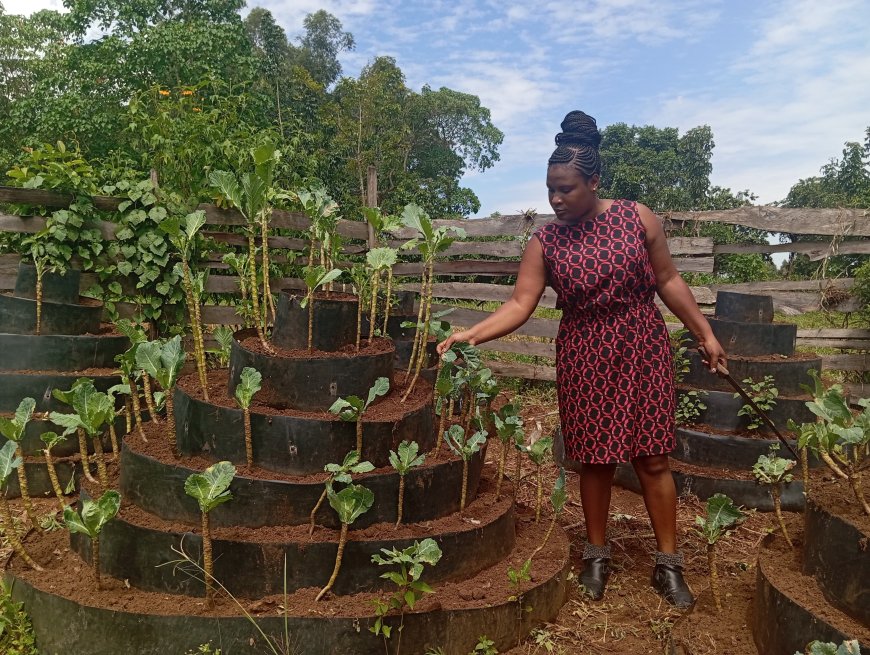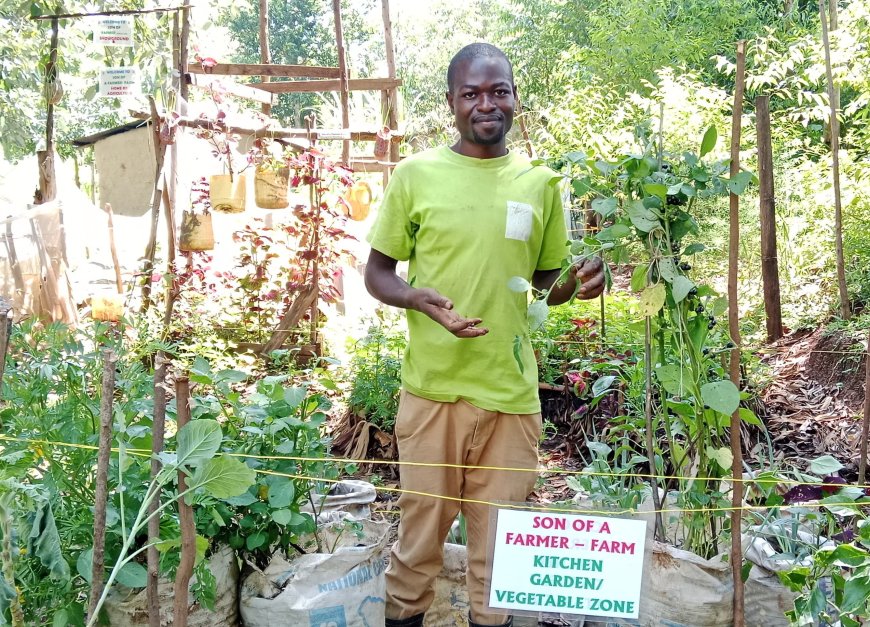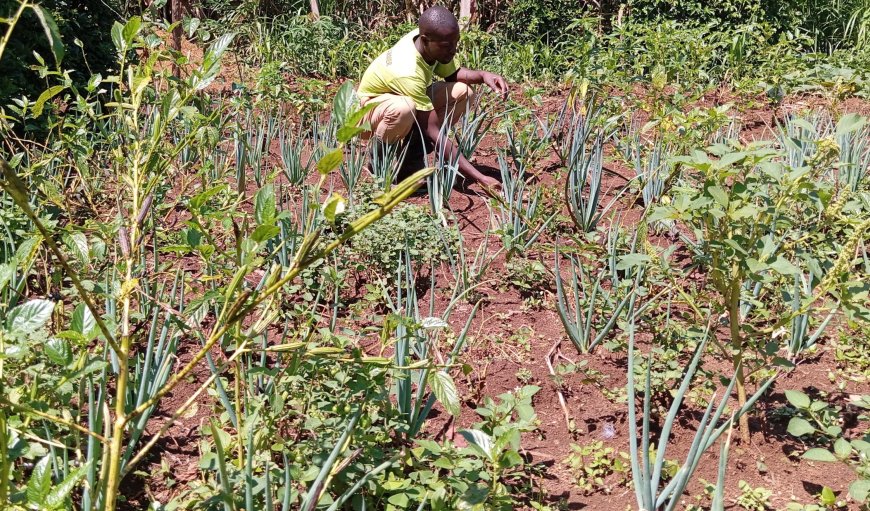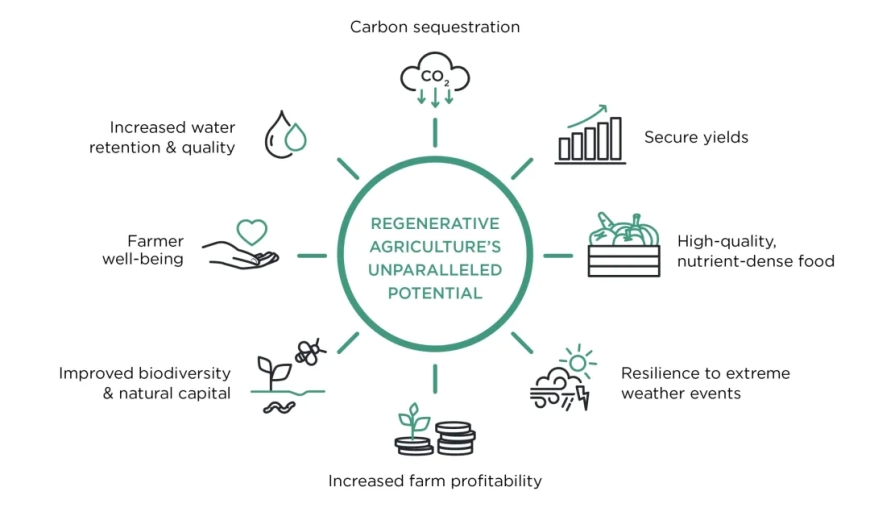Young Kenyan Farmers Revolutionizing Agriculture through Regenerative Practices
Regenerative agriculture consists of nature-based farming practices such as inter-cropping, crop rotation, cover cropping, planting indigenous seeds, minimal or no tillage, organic farming, and agroforestry.
When Mercy Ochango, 29, graduated from Egerton University with a Bachelor’s degree in Agribusiness Management in 2021, she hoped to get a well paying job.
Mercy was however groping in darkness as to where exactly she would practice her newly acquired skills when she returned home, given the cultural perception that women from the Luhya community, where she hails from, could previously not inherit land from their parents.
Her parents overlooked this outdated cultural belief and granted her permission to use a small section of their homestead in Lurambi Sub-county in Kakamega County, which previously hosted an old house.
This space, measuring about 300m2 and filled with stones from the demolished house, became the springboard for Mercy to actualise her dreams of revolutionizing agriculture back at home.
Determined to prove a point, Mercy installed several cone gardens, a sustainable and space-efficient farming method. These towering gardens brim with vibrant vegetables year-round, providing fresh produce for her family and the neighbourhoods.

Cone gardens
“When my parents offered me this small space, they doubted I would do anything meaningful with it. I saw a hidden treasurer. I filled the space with cone-shaped mini gardens and then planted a variety of vegetables, including kales, African indigenous vegetables and carrots,” says Mercy.
“Ordinarily, a space occupied by one cone can only accommodate 15 plants but when a cone is installed in the same space, it can hold up to 120 plants, hence increasing yields from small spaces. In addition, cone gardens are easy to manage, allowing me time to venture into other activities during the day. A well maintained cone can last up to seven years,” she adds.
Mercy’s impact extends beyond her kitchen garden. She has opened a shop in Kakamega town from her proceeds from the farming activities where she sells cone garden materials and offers installation services to farmers at a fee. Her thriving venture has also become an admirable innovation in the community as she provides training on regenerative agricultural practices to interested local farmers. The 29-year-old farmer is cultivating crops and nurturing young farmers towards farming and land use in Western Kenya where the sizes of land is diminishing due to population pressure.
“I am inspired by the idea of contributing to food security and community well-being through regenerative agriculture. It offers a healthier and more sustainable way of food production. I am motivated by the opportunity to innovate and be at the forefront of a movement that is reshaping the future of farming,” she states.
About 40 kilometers away from Mercy’s home, I met another young farmer practicing regenerative agriculture. In the landscapes of Kivaywa area in Malava Sub-county resides Kefa Zakayo, a farmer whose transformation is inspiring change in his community.

Kefa Zakayo
“I named myself son of a farmer because I learned the art of farming from my father since I was ten. He used to plant maize, beans and sugarcane. However, with the setback of the sugarcane sector in the country, I saw an opportunity for reinventing the wheel. I uprooted the sugarcane on my farm and embarked on a journey to practice a more productive farming venture,” Kefa tells me.
Every part of Kefa’s farm is a productive space filled with either crops or shelters for his livestock. Upon entering the homestead, one is ushered in by a printed message on a laminated white paper stating ‘YOU ARE NOW ENTERING SON OF A FARMER’S FARM. In one section, he cultivates different indigenous vegetables, cassava, arrowroots, onions, and sweet potatoes, among other food crops on well-labelled plots of raised beds. He notes that this is a measure of retaining water in the soil. He has also planted a variety of fodder crops to prevent soil erosion and provide feeds for his livestock.
Kefa is committed to pure organic farming, using organic manure made from composted plants and animal dung to provide required nutrients for his crops. In addition, he uses natural pest deterrents like marigold plants, onions and rabbit urine rather than chemical pesticides. His land is also a flourishing agroforestry system, evidenced by a forest of grafted fruit trees like the hass avocados, apples, mangoes, passion fruits, pawpaw and bananas. In one corner lies a protected area housing five ponds of aquatic plants, which he uses to feed his poultry. Moreover, Kefa practices a circular economy to maximize land use, where he has creatively re-purposed old clothes, plastic containers, and cement bags as planting spaces.
Beyond farming, Kefa’s land is an educational hub where other farmers and students from nearby schools visit to learn about regenerative agriculture. His undertakings are to sustain his family to live a better and healthier life, noting that the income he gets from the farm boosts the one he gets from his day job in ICT as a cyber cafe attendant.

Kefa on his land
Mercy and Kefa are a sample of young farmers from the Western part of Kenya who are using regenerative agriculture to revolutionize the sector, provide food and create employment.
What is regenerative agriculture?
Professor Francis Muyekho, an Agronomist and currently a lecturer in the Department of Agriculture and Land Use Management at Masinde Muliro University of Science and Technology, defines regenerative agriculture as a holistic and sustainable farm management method that offers sustainable solutions to the challenges faced by farmers practicing conventional farming.
“Farmers are used to planting the same type of crops using synthetic fertilizers and chemicals. Machinery, mostly fossil fuel-powered, is also used to till land. This type of farming is mostly seasonal as it is rain-fed. Conventional farming has declined soil health, degraded land, reduced land size and crop yields, and has had negative impacts on the ecosystem,” explains Prof. Muyekho.
“This calls for a sustainable farming practice that will save farmers from negative externalities of conventional agriculture by restoring our lands, improving soil health, retaining water in the soil, boosting crop yields long term, protecting biodiversity and being friendly to the planet,” he adds.
Regenerative agriculture consists of nature-based farming practices such as inter-cropping, crop rotation, cover cropping, planting indigenous seeds, minimal or no tillage, organic farming, and agroforestry. Prof. Muyekho notes these practices enhance soil fertility, structure, and overall ecosystem health.

Its potential
Sustainable Development Goal 2 advocates for Zero Hunger in the world by 2030. However, as of 2023, the World Food Programme (WFP) estimates that over 333 million people are facing acute food insecurity, and up to 783 million are experiencing chronic hunger. Closer to home, Kenya has a score of 22.0 in the 2023 Global Hunger Index ranks placing it at position 90 out of the 125 countries. This indicates that we have a profound level of hunger.
With approximately six years remaining before the deadline for SDGs, Prof. Muyekho calls for action to ensure a sustainable supply of safe, nutritious, and sufficient food . He notes that regenerative agriculture has the potential to create more adaptable and sustainable food systems that can increase food productivity, hence addressing food insecurity. This is supported by a peer-reviewed journal called Sustainability, which found that yields increase by 20 per cent when regenerative agriculture techniques are used.
Furthermore, he says that farmers have suffered from the adverse effects of climate change caused by human activities like unfriendly agricultural practices. Prof. Muyekho observes that regenerative agriculture offers solutions to this climate crisis.
“Agriculture is a major contributor to GHG emissions into the atmosphere which leads to global warming and climate change. Climate change is a pain to farmers who lose their crops to unpredictable weather patterns, pests and diseases among other susceptible climate induced challenges. Regenerative agriculture incorporates climate-smart practices, such as cover crops and reduced tilling, which captures the emitted carbon dioxide and stores it in the soil (carbon sequestration). This helps reduce global warming as well as improve the soil health,” he informs.
Apart from climate action and addressing food security, regenerative agriculture could also boost the worlds economy. Fortune Research Insights, a global market research institution, predicts that the regenerative agriculture market might reach a value of 333.18 million USD by 2027. This strong trend reflects increasing investment and consumer interest in sustainable agriculture.
Adoption of regenerative agriculture
Although advocates for regenerative agriculture emphasize the need for the world to re-embrace this practice, they note that its adoption among farmers is slow.
According to Thiong’o Gachie, a Regenerative Agriculture Specialist working with Feedback to the Future, a non-governmental organization that trains farmers nationwide on transitioning to this practice, the slow adoption pace is attributed to insufficient knowledge at the farmer level.
“Regenerative agriculture was practiced many years ago. However, it was overtaken by conventional agriculture. It’s re-adoption has been low because farmers lack the crucial practical knowledge. We need to increase awareness among small-holder farmers and agricultural organizations on the importance and potential of this practice,” states Thiong’o.
He also notes that the continuous promotion of conventional agriculture, for instance, the government’s subsidy programs on synthetic farm inputs, has also played a role in promoting slow adoption of regenerative agriculture.
“Farmers are desperate for increased yields with low cost of production, while ignoring the other parts of the system. However, regenerative agriculture is more information dense than input dense. Farmers will gradually adapt to this practice if they are taught on how to manage their farms in a way they can benefit from,” he explains.
Role of youths in accelerating regenerative agriculture
In most cases, the older adults have been at the forefront of practicing agriculture. However, dynamics are changing with increased knowledge among the youths about the importance of sustainable agriculture in meeting food security goals, climate action, and economic empowerment. .
Thiong’o notes that regenerative agriculture offers vast opportunities for the youth to explore while incorporating creativity and innovations.
“We often concentrate on the production part of the food supply chain. However, there are numerous avenues that youths can explore in regenerative agriculture such as value addition. For example, one can make organic yogurt from the dairy products they get from their farm,”
He advices stakeholders to address issues such as capital intensity, minimal resources, and lack of information, which demotivates youths from engaging in agriculture.
Professor Muyekho, on the other hand, advocates for a change in the higher education curriculum where sustainable agriculture, including regenerative agriculture, is incorporated into agricultural courses to bridge the knowledge gap among youths. This, he notes, will increase the number of people who will either practice the acquired knowledge on sustainable agriculture or advocate for societal change.
AUTHORS
Sharon Ambani Tamba
SOURCE
Originally published on storyspotlight.co.ke
PHOTO
© Sharon Ambani Tamba/StorySpotlight